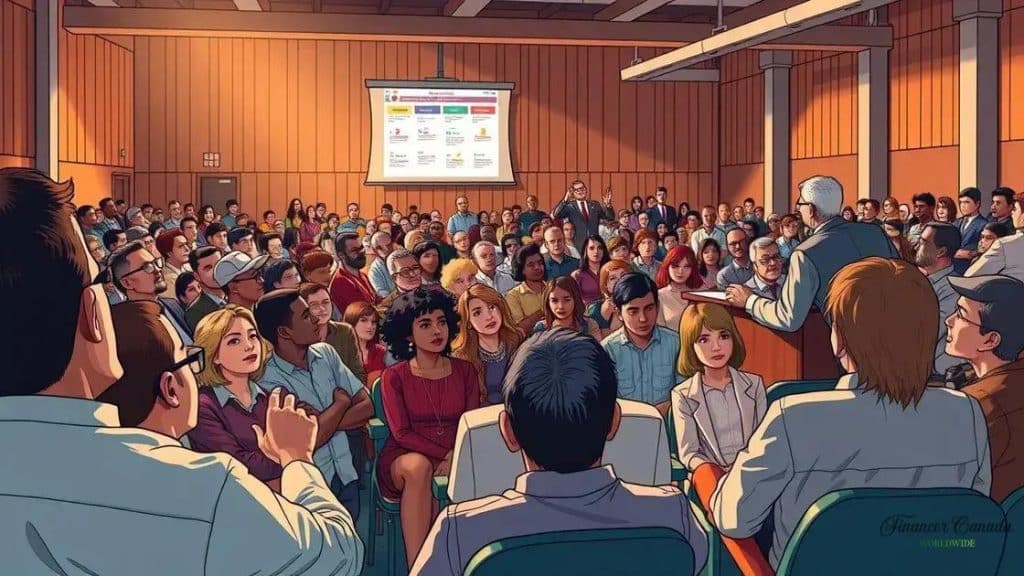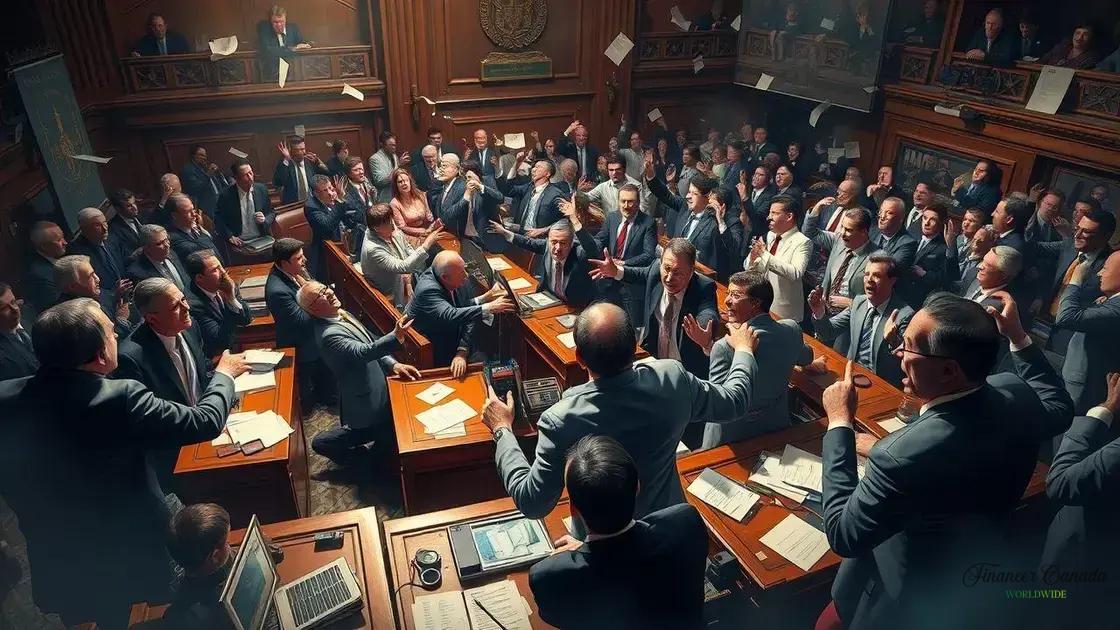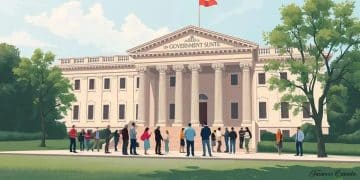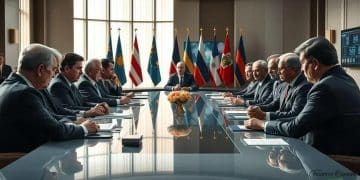Political polarization in Western democracies: understanding the divide

Political polarization in Western democracies leads to increased partisanship and gridlock, negatively impacting governance and public trust, making it crucial to implement strategies that promote empathy and open dialogue.
Political polarization in Western democracies has become a pressing issue, affecting social cohesion and policy-making. Have you ever noticed how conversations about politics can quickly become heated? Let’s dive into the factors driving this divide and what it means for our societies.
Defining political polarization
Defining political polarization is crucial to understand how it influences Western democracies. This term refers to the growing divide between different political ideologies, leading to mutual hostility and identification with one’s own side over the other.
Political polarization has become more pronounced over the past few decades, influencing not just politics but the everyday lives of citizens. In this section, we will explore the characteristics and dimensions of political polarization.
Characteristics of Political Polarization
Political polarization often manifests in several ways:
- Partisan Sorting: Individuals increasingly align with parties that match their values, leading to a more divided electorate.
- Social Separation: People tend to associate with those who share their political views, which can limit exposure to differing opinions.
- Hostility Towards Opponents: Polarized individuals often view those from opposing parties as threats, increasing societal tension.
Understanding these characteristics helps clarify why political discussions can be so intense. As political polarization deepens, it influences media, education, and community dynamics.
Dimensions of Political Polarization
Political polarization can also be divided into various dimensions, including ideological rifts and affective polarization. The ideological divide involves differences in beliefs about government roles and policies, while affective polarization refers to how strongly individuals feel about the ‘other side.’ These dimensions interact to create an environment where constructive dialogue becomes challenging, and divisive narratives flourish.
By defining these aspects of political polarization, we can grasp better its implications for democracy and civic life. Recognizing the signs allows societies to address and potentially mitigate its adverse effects on governance and community engagement.
Historical context of polarization

The historical context of polarization provides insight into how today’s political environment evolved. Understanding the events that shaped public opinion helps explain the current climate of divisiveness.
Political polarization has roots in significant historical events, such as the civil rights movement, the Vietnam War, and various economic crises. These moments often exposed deep societal rifts, leading to ongoing disputes over fundamental values.
Major Events That Influenced Polarization
- The Civil Rights Movement: This movement highlighted inequalities and created sharp divisions between those championing equality and those resisting change.
- The Vietnam War: Public sentiments about this conflict fueled dissent and division, further entrenching political identities among Americans.
- Economic Crises: Financial downturns often exacerbate divides as different groups propose contrasting solutions, deepening existing hostilities.
These events marked pivotal moments in the history of political polarization. As society grappled with the outcomes of these conflicts, a trend emerged where individuals increasingly identified with their political parties. This identification became a source of pride for some, while for others, it sowed distrust.
Evolution of Political Parties
Over time, political parties themselves evolved, with shifts in ideology leading to the realignment of voter bases. The emergence of new movements and parties often highlighted these divisions even further. Today, political groups represent not just different policies but distinct worldviews.
Understanding the historical context of polarization can help citizens navigate today’s complex political landscape. By recognizing the origin of these divides, individuals can engage more effectively in discussions and seek to bridge the gaps that separate them.
Impact on voter behavior
The impact on voter behavior due to political polarization is significant. When individuals identify strongly with their political party, it shapes how they perceive candidates and policies. This behavior extends beyond merely choosing a candidate; it affects how individuals engage with politics overall.
Polarization leads voters to become more entrenched in their beliefs, often ignoring information that contradicts their views. As a result, the information they consume is often biased, leading to a cycle of misinformation and reinforcement of existing opinions.
Characteristics of Polarized Voter Behavior
- Increased Party Loyalty: Voters are more likely to support their party regardless of candidate quality or policies, focusing instead on party affiliation.
- Emotional Decision-Making: Political choices are often driven by emotions rather than rational evaluation, making discussions more heated.
- Selective Exposure: Many voters only consume news that aligns with their pre-existing beliefs, limiting their understanding of opposing viewpoints.
This change in behavior can have long-lasting effects on electoral outcomes. It often results in a lack of compromise and increased political tension as parties become more extreme in their positions. As citizens become polarized, they may also engage less in conversations with those holding opposing views. This leads to a fragmented public sphere, where dialogue and understanding diminish.
The Role of Social Media
Social media plays a crucial role in amplifying polarized voter behavior. Platforms allow individuals to connect with like-minded peers and filter out dissenting opinions. Algorithms often prioritize content that resonates with users; thus, echo chambers can easily form.
The impact on voter behavior becomes evident as social media influences how voters perceive not just their own party but also rivals. Understanding these dynamics is crucial for fostering a healthier democratic process, encouraging open discussions and bridging divides among voters.
Consequences for governance

The consequences for governance due to political polarization are profound and complex. As parties become more entrenched in their beliefs, it increasingly impacts decision-making processes, legislative efficiency, and overall governance.
One immediate effect of polarization is the rise of gridlock in government. When parties are unable to find common ground, passing laws can become exceedingly difficult. This lack of cooperation often results in stalled legislation, which can hinder progress on critical issues.
Effects of Polarization on Governance
- Increased Partisanship: Elected officials may prioritize party loyalty over the needs of their constituents, leading to policies that reflect party ideologies rather than public interest.
- Escalating Conflict: Debates can become more contentious, with a focus on personal attacks rather than constructive discourse, diminishing the quality of policymaking.
- Reduced Public Trust: As citizens see their representatives more focused on party battles, trust in government institutions tends to decline, making it harder for officials to implement policies effectively.
This environment creates a cycle where citizens’ disillusionment with politics further entrenches polarization. As public trust erodes, voter engagement may diminish, leading to lower participation in democratic processes.
Long-Term Implications
Over the long term, the consequences of polarization can lead to significant changes in governance structures. Political parties may shift their platforms to appeal to their voter bases, leaving important issues unaddressed. In extreme cases, this fragmentation can lead to more serious divisions within society.
The consequences for governance demand attention and action. By understanding these effects, citizens and leaders can work toward strategies that promote compromise and collaboration, essential for a healthy democratic process.
Strategies to bridge the divide
Strategies to bridge the divide in politically polarized environments are essential for fostering dialogue and understanding. As divisions deepen, it becomes increasingly important to find common ground and create opportunities for collaboration across different perspectives.
One effective strategy is promoting open dialogue between opposing groups. This can be achieved through community forums, workshops, and town hall meetings where individuals can share their views in a respectful environment. When people hear each other’s stories, they may find shared values that transcend political differences.
Effective Approaches to Promote Understanding
- Encouraging Empathy: Developing programs that encourage individuals to consider the experiences and feelings of others can foster deeper connections.
- Facilitating Civic Education: Providing resources that educate citizens on political processes and the importance of participation can empower more informed discussions.
- Engaging Youth: Initiatives that involve young people in civic activities can help instill values of collaboration and understanding from an early age.
In addition, utilizing social media responsibly can help counteract the polarization often seen in online discussions. By promoting positive interactions and sharing diverse viewpoints, users can create a more balanced digital environment. However, it is important to be mindful of the content shared and to engage with others respectfully.
Building Coalitions
Another approach is to build coalitions among diverse groups to address common societal issues. These coalitions can work together to advocate for policies that benefit all, transcending partisan lines. Collaborative efforts can amplify voices and unite different perspectives for a common cause.
The drive to implement strategies to bridge the divide is not only crucial for personal relationships but also for maintaining the health of democratic institutions. It requires collective effort and a commitment to actively listening and seeking solutions that benefit the community as a whole.
FAQ – Frequently Asked Questions about Political Polarization
What is political polarization?
Political polarization refers to the growing divide between people based on their political beliefs, making it hard for them to find common ground.
How does political polarization affect governance?
It increases partisanship and gridlock, making it difficult for governments to pass laws and respond to societal needs.
What strategies can help bridge political divides?
Encouraging empathy, facilitating civic education, and promoting open dialogues through community forums can help bridge divides.
Why is engaging younger generations important?
Engaging youth in political discussions fosters understanding and encourages a future where collaboration and respectful discourse are prioritized.





